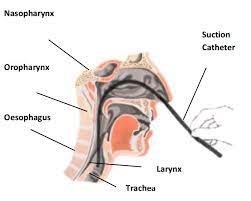A nurse is performing nasopharyngeal suctioning for an adult client. Which of the following techniques should the nurse use?
Apply intermittent suction for 30 seconds.
Insert the catheter 10 cm (4 in).
Apply suction while inserting the catheter.
Wait 1 min between suctioning attempts.
The Correct Answer is D
Waiting 1 minute between suctioning attempts allows the client to recover and ensures that the procedure is not overly invasive. It also helps to prevent the client from becoming hypoxic.
The distance that the nasopharyngeal catheter should be inserted varies from person to person and therefore 10 cm is not standard.
During nasopharyngeal suctioning, the nurse should apply suction intermittently while withdrawing the catheter, not during insertion. Applying suction during insertion can cause tissue damage and increase the risk of trauma.
The nurse should also apply intermittent suction for no longer than 15 seconds to prevent hypoxia and damage to the mucosal lining. Suctioning for an extended period can cause discomfort and harm to the client.

Nursing Test Bank
Naxlex Comprehensive Predictor Exams
Related Questions
Correct Answer is C
Explanation
A.While increasing dietary fiber can help with constipation, a common side effect of iron supplements, it does not directly improve the absorption of the medication
B.Berries and citrus fruits, on the other hand, are good sources of vitamin C, which can actually enhance iron absorption. Therefore, eliminating them from the diet would not be beneficial for improving iron absorption.
C.The recommendation the nurse should make to improve the absorption of the iron supplement (ferrous sulfate) is to avoid drinking milk with the medication. Calcium in milk can interfere with the absorption of iron, so it is best to separate the consumption of these two substances.
D.Green tea contains compounds called tannins, which can interfere with iron absorption. Therefore, it is not recommended to take iron supplements with green tea.
Correct Answer is B
Explanation
As a nurse, the intervention that should be recommended is encouraging the client to take frequent walks during the day. This will help the client expend some energy and reduce the restlessness that could be causing the sleep disturbance at night.
The other options are not recommended because barbiturate medications can cause excessive sedation, allowing the client to nap for at least 1 hour during the day can interfere with their ability to sleep at night, and putting a lock on the client's door can be a safety risk in case of an emergency.
Whether you are a student looking to ace your exams or a practicing nurse seeking to enhance your expertise , our nursing education contents will empower you with the confidence and competence to make a difference in the lives of patients and become a respected leader in the healthcare field.
Visit Naxlex, invest in your future and unlock endless possibilities with our unparalleled nursing education contents today
Report Wrong Answer on the Current Question
Do you disagree with the answer? If yes, what is your expected answer? Explain.
Kindly be descriptive with the issue you are facing.
